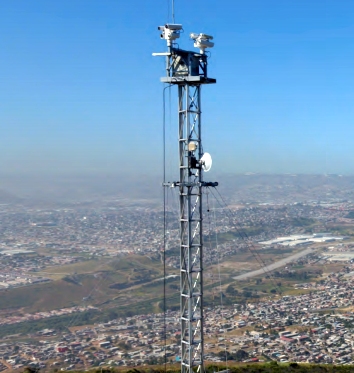
Application
The Towers Watch (TW) is designed for homeland security to protect all kinds of border areas, land and sea, in the fight against different types of threats, but can also be used for remote monitoring and surveillance of various civilian facilities and strategic infrastructures. TW is a self-sufficient, state-of-the-art surveillance system, allowing detection, identification, tracking, and finally interception and capture of intruders, day and night.Its electro-optical system contains a multi-spectral surveillance subsystem. This mid-range system was designed with multi-spectral imaging to see in complete darkness as well as in a multitude of environmental conditions, including smoke, rain, snow, dust and fog through the use of an uncooled, continuous-zoom VOx detector and a high-resolution, optical-zoom color CCD camera. TW is fully managed via a Command and Control (C2) system (secondary control room). All data from the TW is routed to the C2 system via wireless, fiber optic, or other communications infrastructure, where it is processed and displayed.
Characteristics
• Persistent surveillance capability: the ability to continuously detect, track, identify, and classify border incursions 24/7 in targeted areas in all weather, terrain, vegetation, and lighting conditions.• Command, Control, Communication, Coordination, and Intelligence (C4I) Capability: the ability to collect and analyze information, exchange information and intelligence, allocate and control resources based on operational requirements, and make informed operational command decisions.
• Sustainment and support capability: the ability to maintain surveillance systems in accordance with operational requirements and capabilities
AFRICA HUB SERVICES offers 3 levels of complementary TW services depending on the needs. The pylons and towers vary between 15 and 120 meters in height depending on the relief. Communication and power supply systems also depend on the existence and proximity of these services. Service and satisfaction capabilities depend on the type of configuration. These capabilities range from simple detection to artificial intelligence, which is why they are graded from C to A,
C Services on Command and Control (C2),
Primary services for surveillance of critical sites or ordinary borders.
The capacity of the radars is 100 objects of interest with the cameras on a short distance. Data recording with C2 is done on site or in nearby facilities.
B Services on Command and Control (C2)
Secondary services for surveillance of critical sites or ordinary borders. The capacity of the radars is 250 objects of interest with cameras on an average distance of 5km. Data recording with C2 is done on site or in nearby facilities.
Services A on Command, Control, and Communications Engineering Center (C3CEN)
Advanced surveillance services for critical sites and borders. The capacity of the radars is 750 objects of interest with the cameras on an average distance of 15km. Data recording with C2 is done on site or in nearby facilities and in the Command Center.
- All identified objects are geo-referenced and the illuminating sensor indicates precisely how to intercept each potential hazard.
- Facial recognition is enabled by default with the classification of each threat and the action to take to annihilate it.
- The artificial intelligence infrastructure controls the entire system from energy, communications to sensors. Thus, it is only triggered in the presence of activity of great interest for its mission.
- The COP/NOC/SOC are integrated by default to give a single view of all situations for quick decision making.


